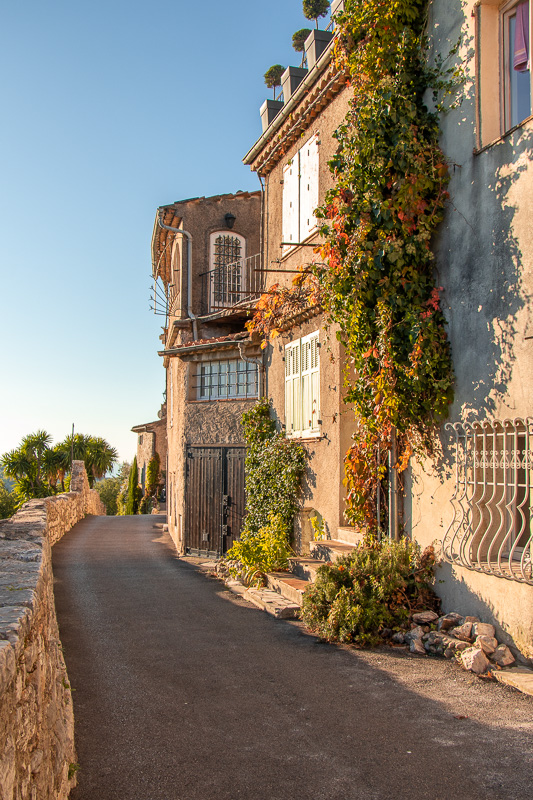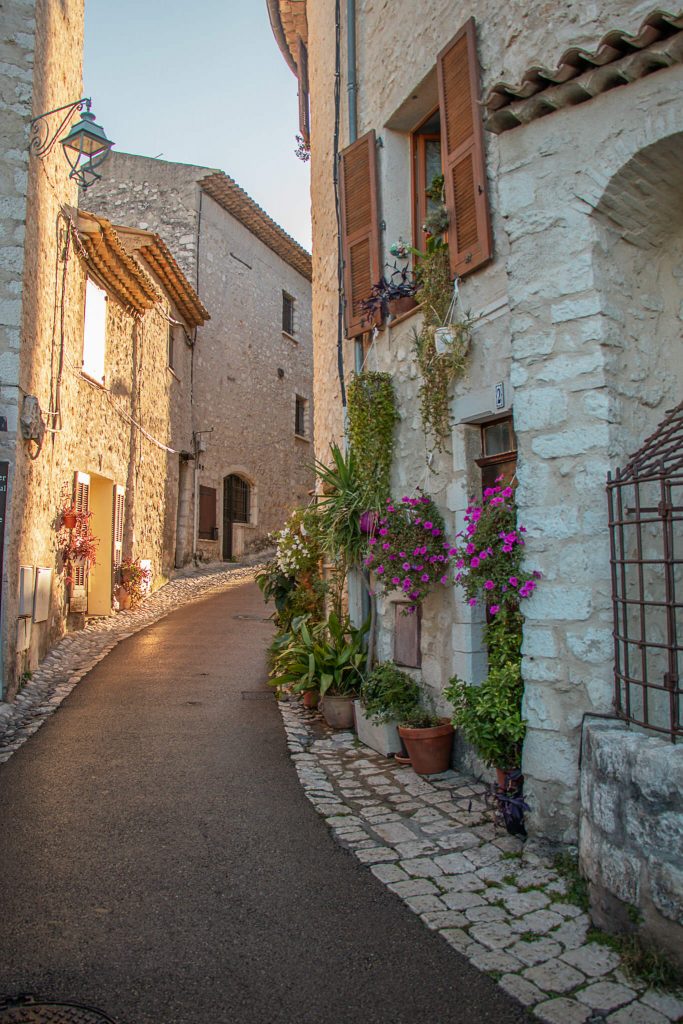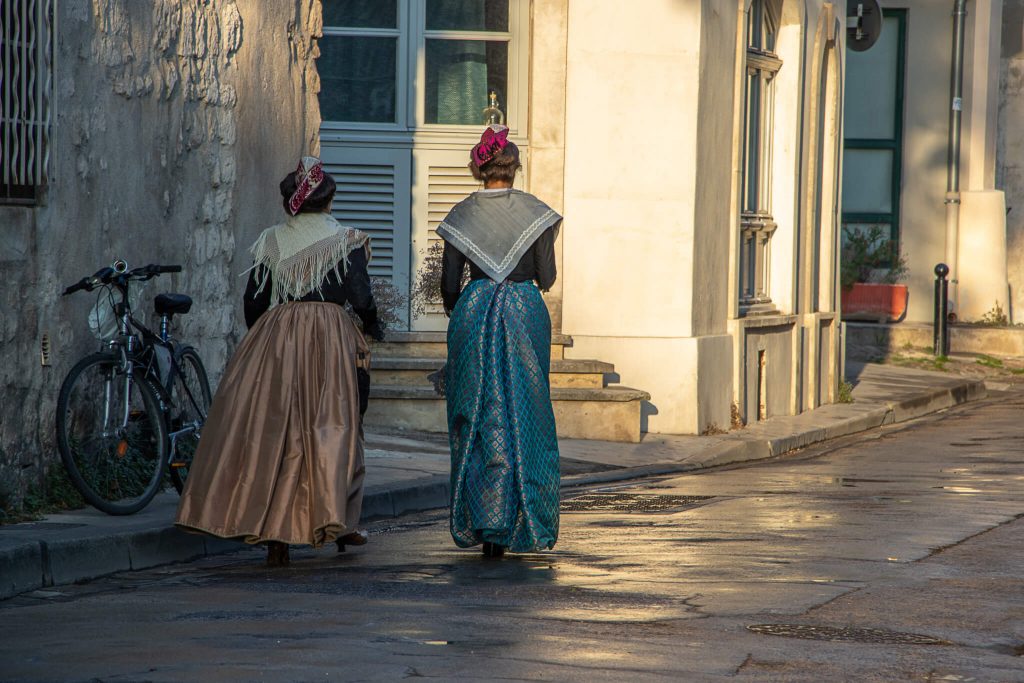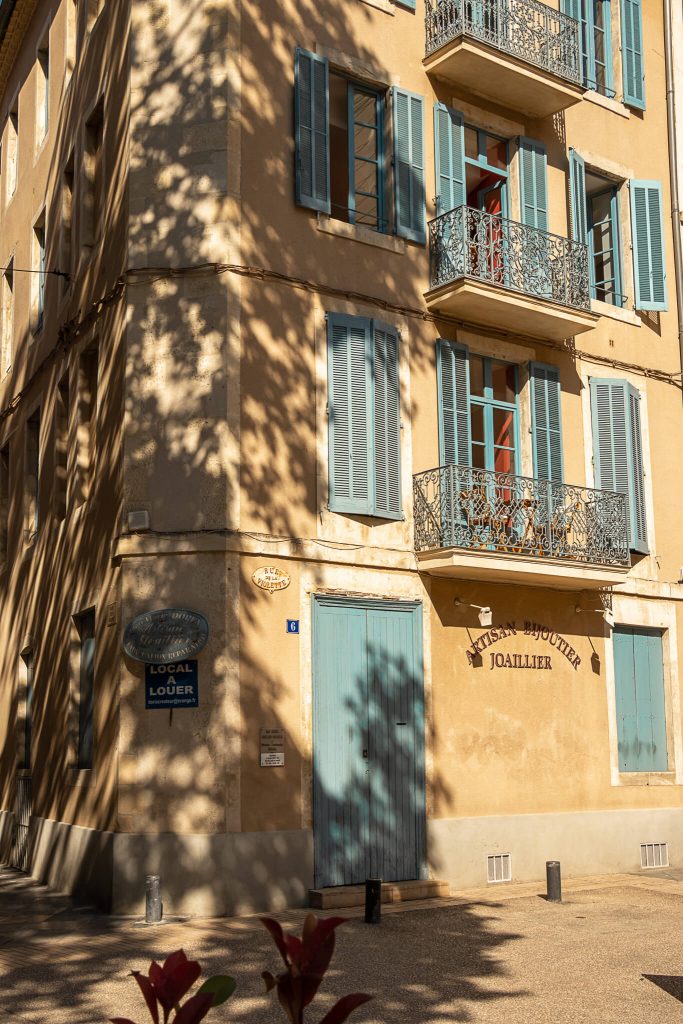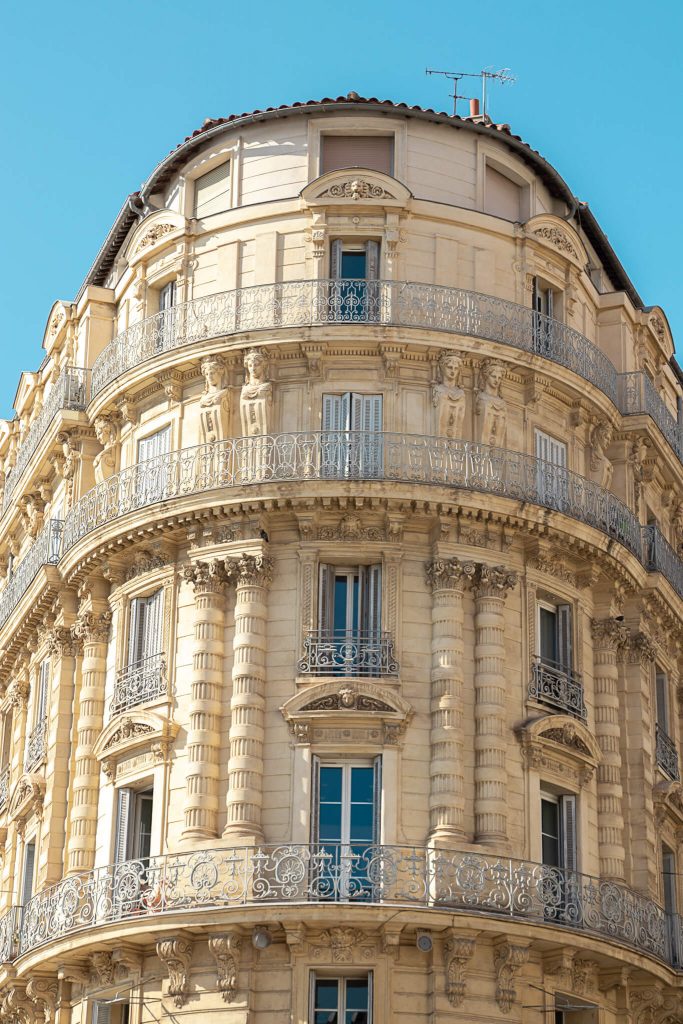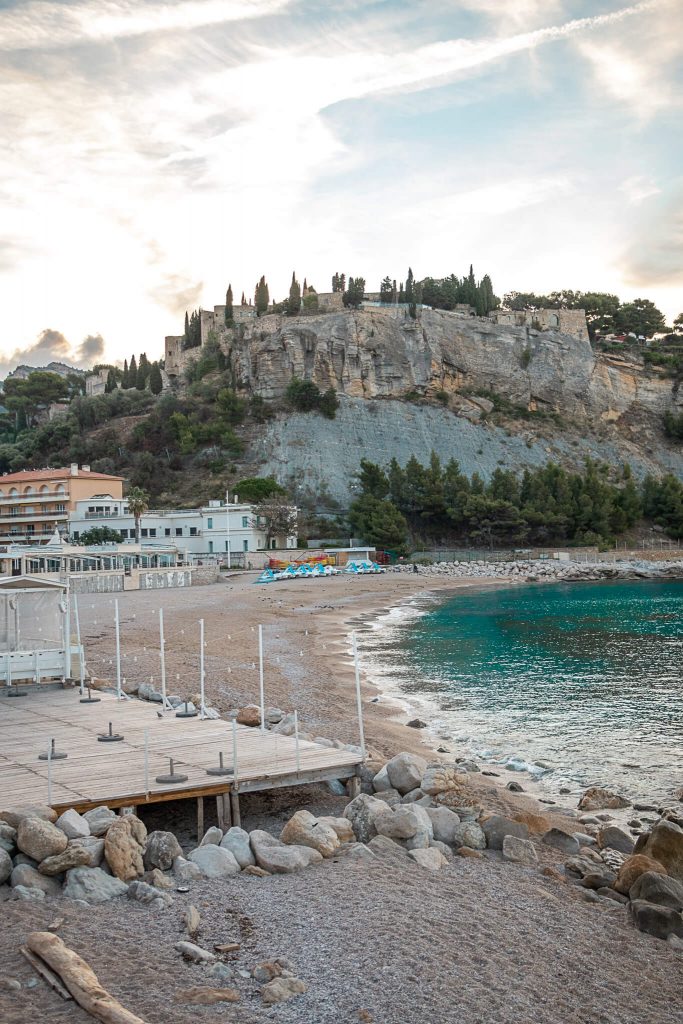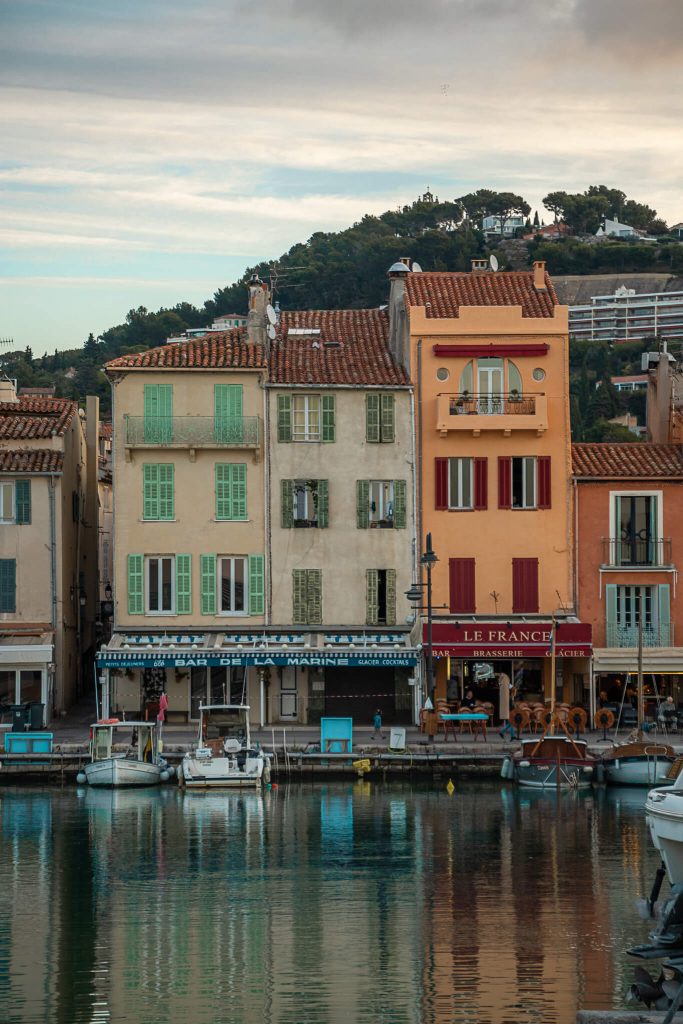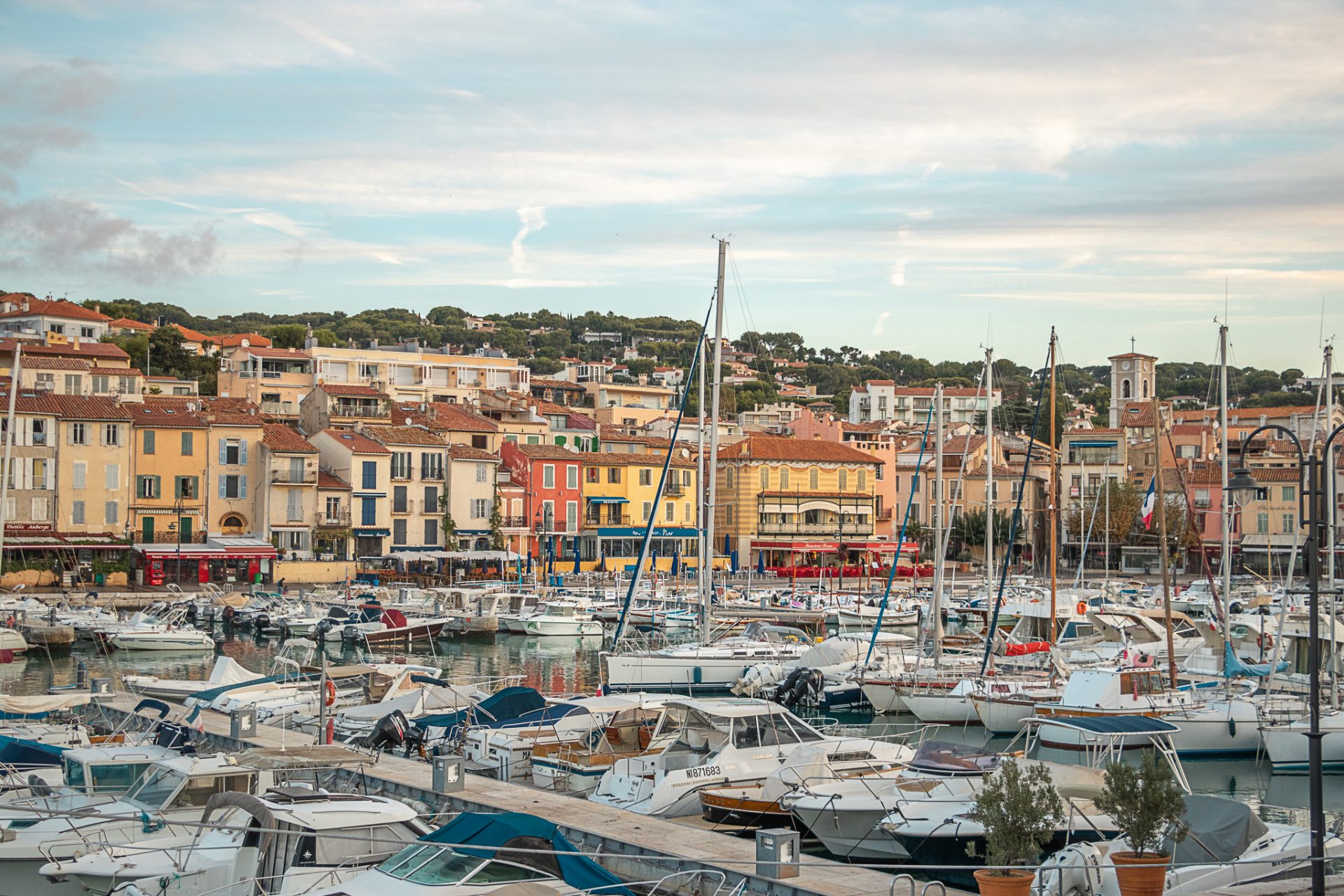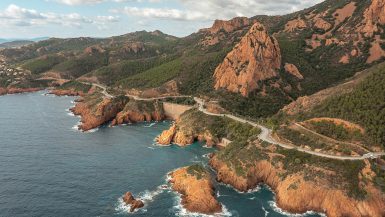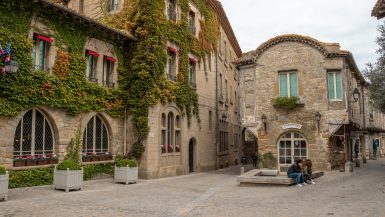We were dreaming of Provence for a long time and finally we managed to make this dream come true! However, we know that we will definitely come back, and that’s because we were after season in Provence and we didn’t have the opportunity to see the lavender fields in full bloom, but we already know that Provence is our vibe, and its medieval towns have a unique charm! We spent a total of 8 days in Provence and on the Cote d’Azur, and we decided to divide the post with places worth seeing into two parts – Provence and the Cote d’Azur. Want to know what to see in Provence? Here’s few places and travel tips we’ve prepared.
General information
Provence is a land in south-eastern France, located in the Provence-Alpes-Côte d’Azur region. After reading the name, you will realize that the region is huge and has a lot to offer! Marseille is the capital of the entire region. What is Provence famous for? Lavender, without a doubt, but in our opinion, picturesque medieval towns and Provencal herbs, probably used everywhere in Europe, should be added to the list.
This is of course a shortened list, and you could talk about the specialties of Provence for much longer! Moving on to the culinary specialties, apart from the herbs mentioned, it is worth mentioning honey, ratatouille (vegetable stew), tapenade (black olive paste) or the well-known aioli. Of course, this is just the tip of the iceberg and we are planning a separate post about food!
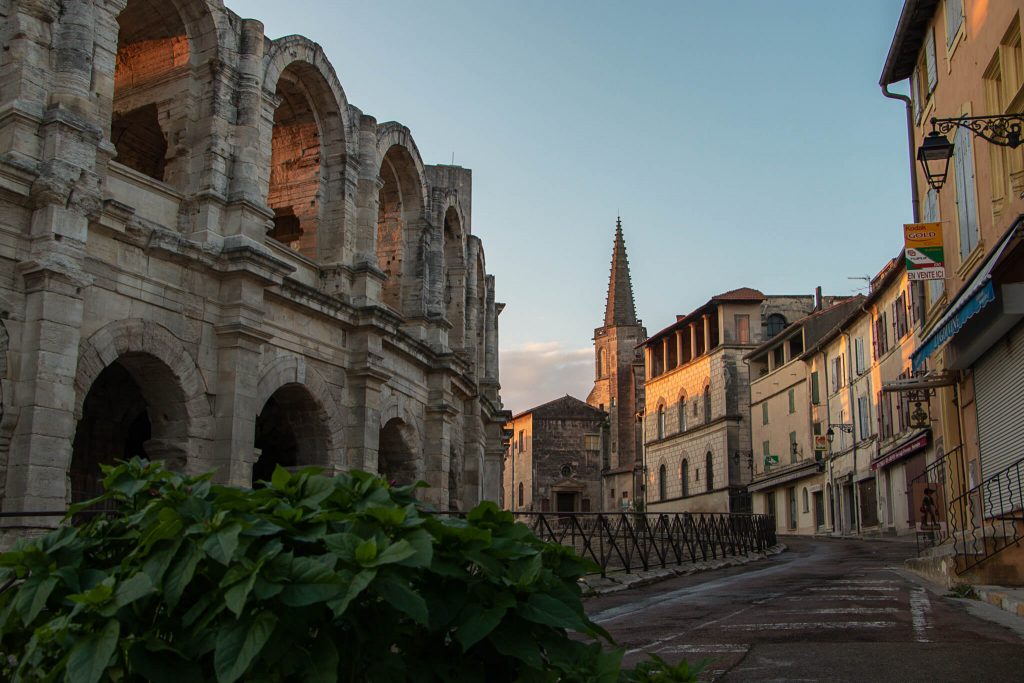
How to get there?
One option is of course a car and a small Eurotrip depending on where you are coming from. If the plane is chosen, the most convenient options will be Marseille or Nice. From other, slightly more distant cities (if you plan to rent a car, it will not be a huge problem – we landed in Carcassone), you can choose Montpellier or Carcassone (unfortunately not many planes land there).
How to get around?
While you can move around the Cote d’Azur quite efficiently by train, in Provence it can be a bit more difficult. There should be no problem with getting to larger towns like Avignon, Nimes, Arles or Marseille, but charming little villages or places like Pont du Gard by public transport will be rather inaccessible. You can search for tickets and timetables on TER or RTM websites.
A car is the most sensible option and it may turn out it is better to leave Poland with your own car than to fly by plane and rent it on the spot. From Ireland most likely plane and rental is the best option. We managed to rent a car for around 280 euro (8 days) with Keddy rental, pick-up and return at a different location, if you pick up and return in the same place, we recommend checking Oui Cars, or ‘Car Airbnb’, where you can rent from private person. We tried it in Corsica and can recommend it!
When to go?
The most pleasant weather in Provence falls between June and September, it will be very warm, but also very crowded, and we cannot imagine some Provencal towns overrun by people . The lavender season starts in mid-June and lasts until mid-August, but a lot depends on the weather and the most certain month is July. If you want to avoid the crowds – we recommend May and October, it will not be hot but during the day it is pleasantly warm (but it’s better to be prepared for the wind!), evenings can be cool.
How many days to spend?
We only had 8 days for Provence and the Cote d’Azur and we know that it is definitely not enough. We recommend spending 7 days in Provence alone, and if you plan to go towards the Verdon canyon and the Alps – 10. You can of course spend a good few months there and not be bored, but we all know how tight it can be with time.
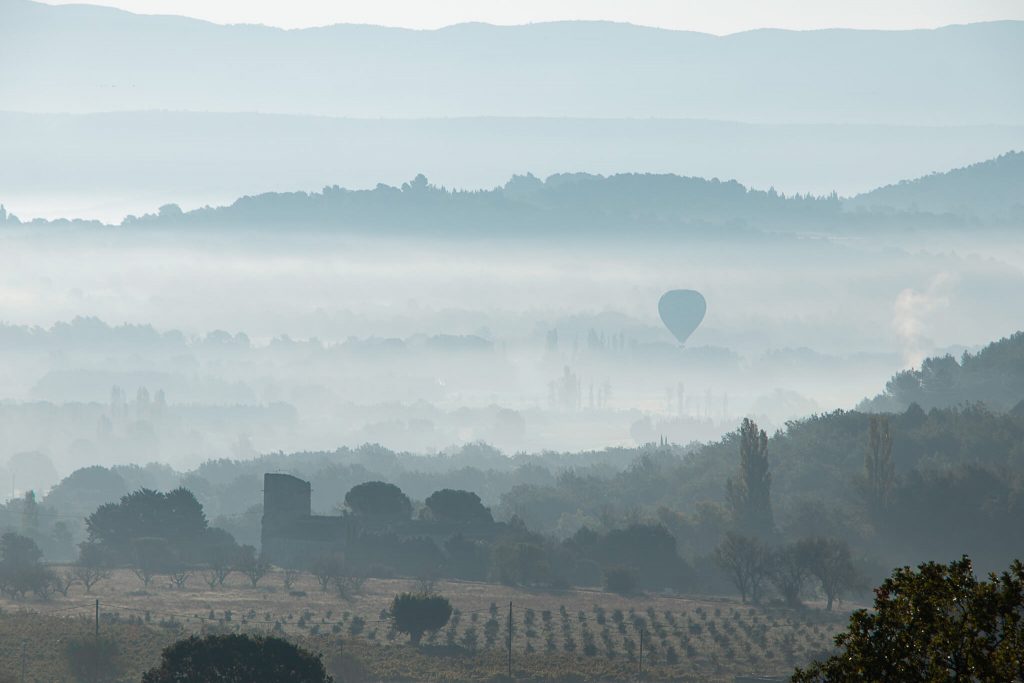
Is Provence expensive?
Unfortunately yes, and we say it as people used to expensive life in Dublin. Southern France was one of the most expensive places we have visited so far in Europe, and it is worth adding that we were there after the summer season. For 8 days of renting a car, we paid 280 euros, the cheapest accommodation we were able to find on Airbnb (a room in someone’s apartment, shared bathroom) was 40-60 euros, for a hotel you have to count at least 80-100 euros (prices after the season!).
Highways are also tolled. When it comes to food – the “set of the day” are the cheapest – depending on the place, 17-30 euro for a multi-course meal (sometimes it is a main course + dessert, sometimes 3 courses), you can also find sets more expensive than 30 euro. This option is definitely cheaper than individual dishes from the menu. A glass of wine 4-6 euros. Of course, to reduce costs, you can eat in fast food restaurants or pizzerias, we relied more on picnics – Carrefour is one of the cheaper shops.
Aigues Mortes – What to see in Provence?
We didn’t have enough time for the town of Aigues Mortes, we only managed to pass it and we were very intrigued. Aigues Mortes is a medieval town surrounded by a high wall, we conclude from the condition of the walls that it is quite well preserved. We came to the area to see salines (Salin d’Aigues Mortes), i.e. reservoirs from which salt is obtained. In this matter, we also failed and arrived too late, you can enter the saline area until 6pm. Salinas have an unusual pink colour, which occurs due to algae presence. From the road crossing salinas we managed to see flocks of flamingos which likes to be in shallow, salty waters. We also managed to stop for drone shots by the road.
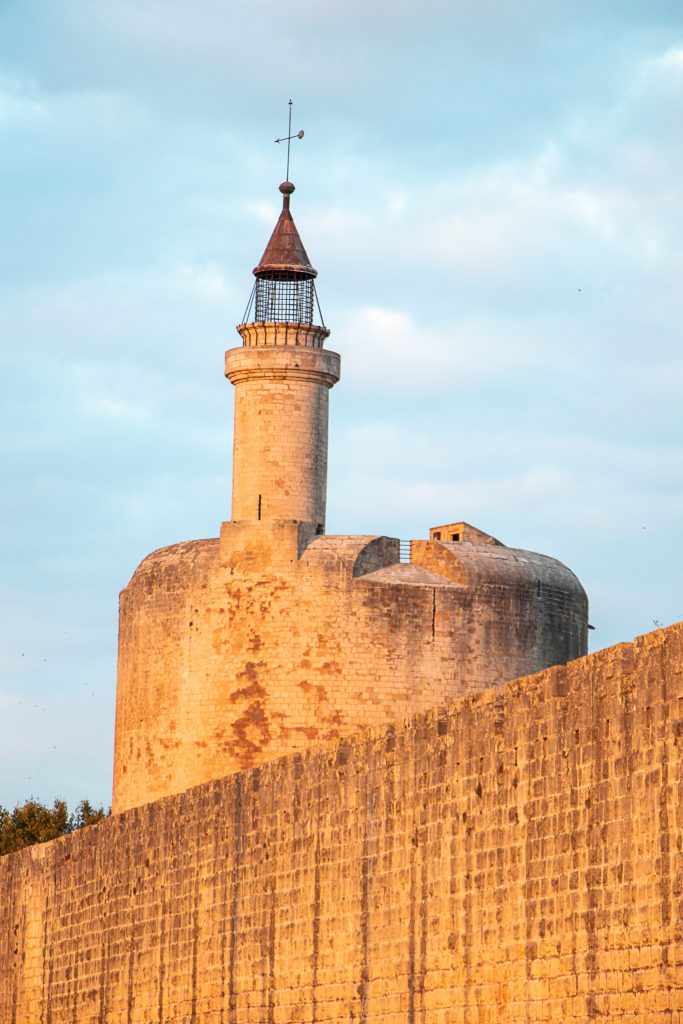
Arles – What to see in Provence?
Arles is a medieval Provencal town, one of those that we would classify as the bigger ones, and definitely one of the coolest places we have visited in the whole of Provence. The most famous place in Arles is the ancient Roman amphitheatre from the 1st century BC, modelled on the Roman Colosseum. It may not be as big and impressive, but it is well-preserved and nicely integrated into the narrow streets of Arles.
In Arles, we were on early Sunday morning, before sunrise, we wandered the streets taking photos, and afterwards we sat down for a caffee creme in one of the few open cafes next to the parking lot outside the medieval city walls. If we hadn’t decided for a coffee, we would probably have missed everything, and what are we talking about? At one point, we saw women in traditional costumes, followed by another and even more after.After drinking the coffee, we paid quickly and rushed after them. As it turned out, they were heading for the arena, for an event whose name and reason, unfortunately, we do not know.
As it turned out, Provence, and Arles in particular, is famous for traditional costumes, which are still worn today at important events and celebrations. Outfits from Arles a few hundred years ago were considered the most chic and elegant, and in the early morning in Arles we felt like we had moved back in time for a good few hundred years! There are a lot of parties and festivals in Arles, we highly recommend you check the calendar and go to one of them!
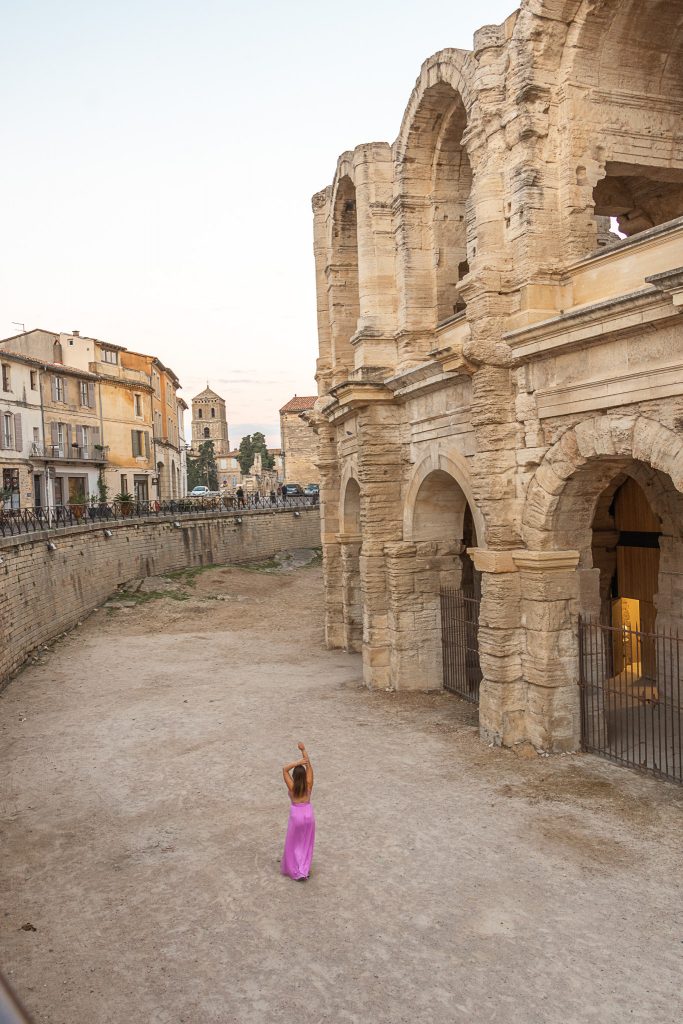
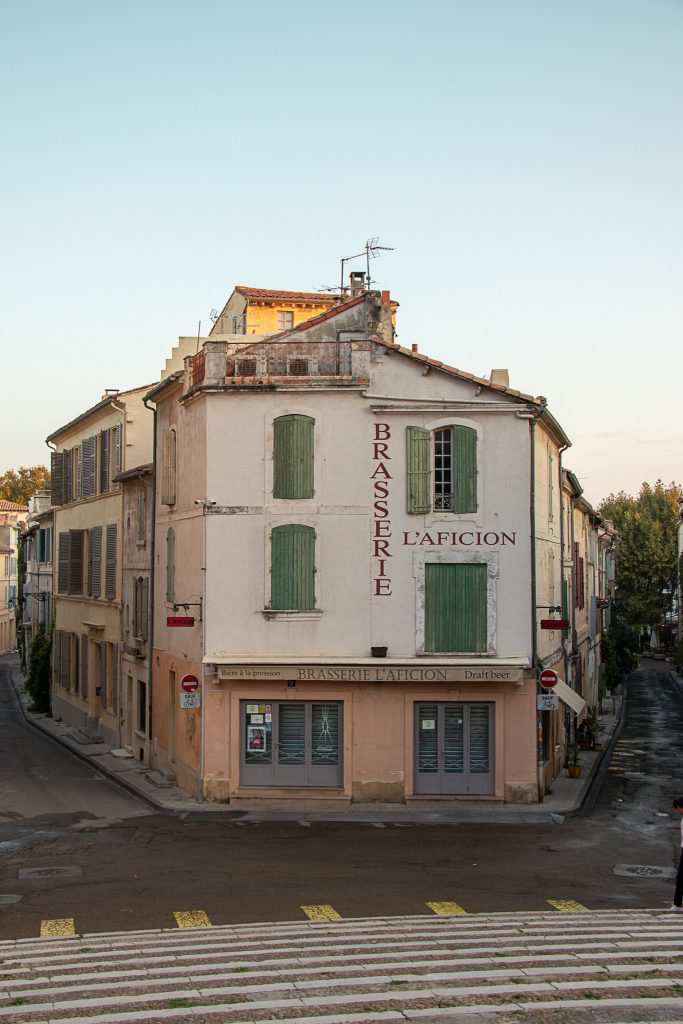
Nimes – What to see in Provence?
Nimes is one of the largest cities in Provence, reportedly often compared to Paris. Although we have never been to Paris itself, Nimes is a place where we both thought that this is how we imagine Paris – we will definitely verify the truth of this feeling in the future. Although we do not fancy larger cities, Nimes captivated us a lot, it has something elegant and pleasant about it, we just felt good there.
In Nimes, as well as in Arles, there is a Roman amphitheatre, equally well preserved and surrounded by a spacious square (in Arles, the amphitheatre is squeezed tightly into urban architecture). An important ancient monument is also La Maison Carree, a temple located at the forum in Nimes. The place that made the greatest impression on us is the 19th century gardens of Jardin de La Fontaine. It is worth noting, that although the gardens themselves were built relatively late, the Romans were the first to build this area, there are Roman ruins as well as the Temple of Diana.
Nimes is one of those places where we only had two hours and we could spend much more. It is also worth adding that the popular and ubiquitous denim, the material from which jeans are made, was created in Nimes and its name comes from the name of the city.
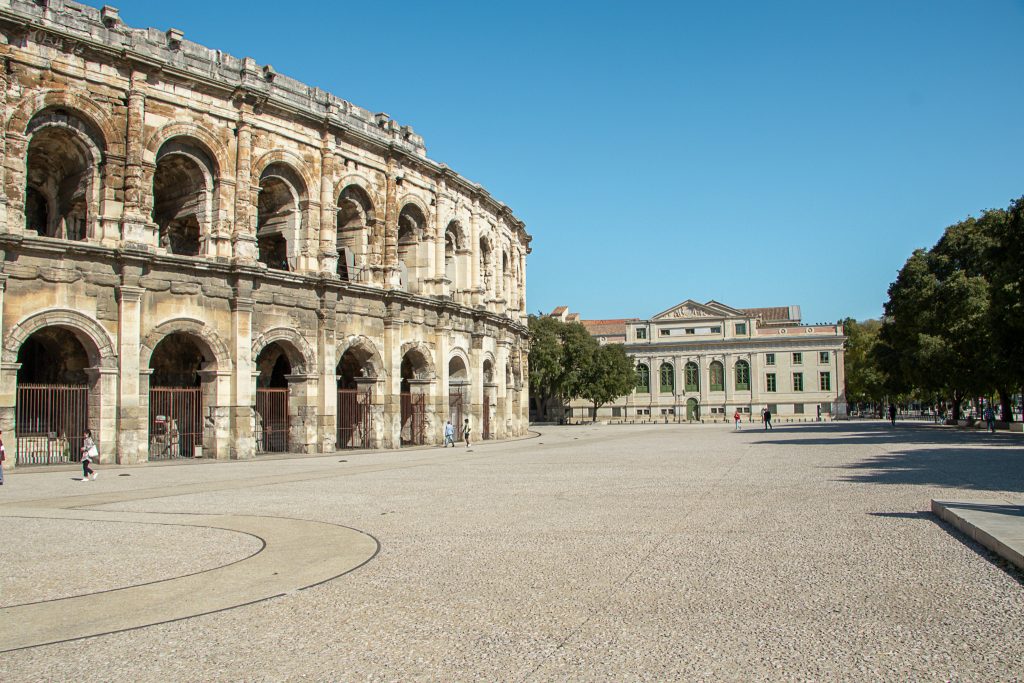
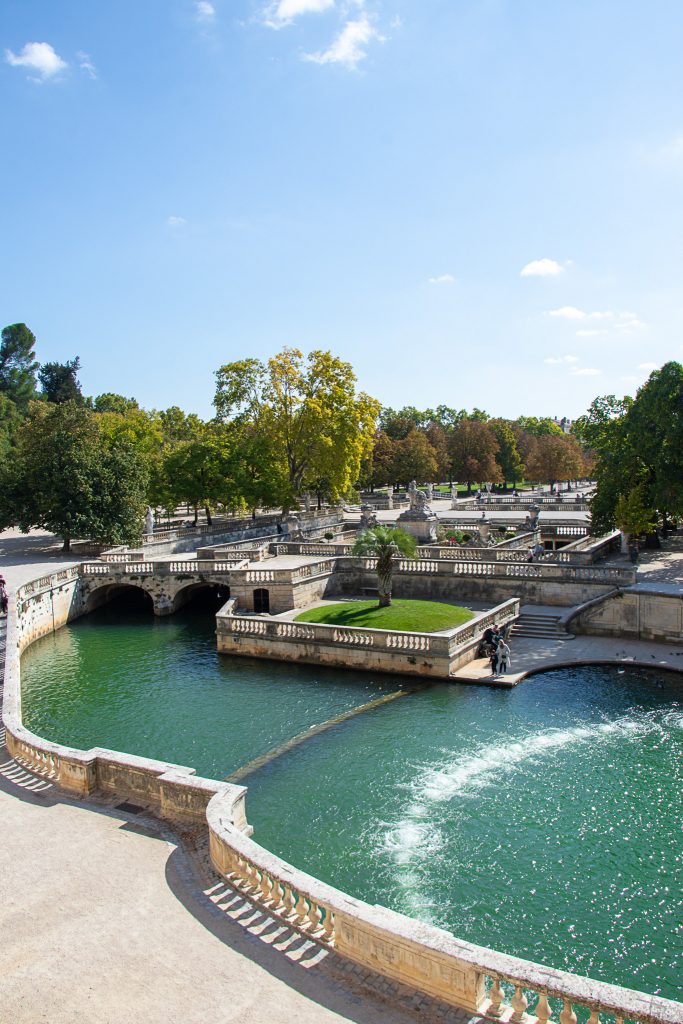
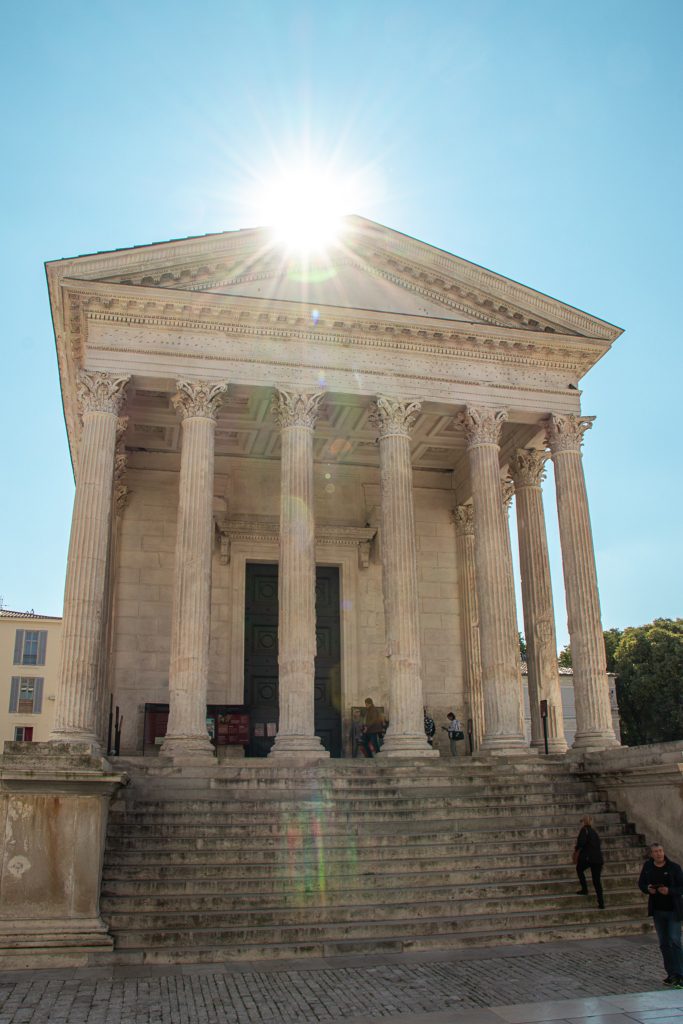
Pont du Gard – What to see in Provence?
The Pont du Gard on the Gard River is part of a 50-kilometer aqueduct built by the Romans in the 1st century BC. The Pont du Gard consists of a three-story arcade, the lower part of which, like a classic bridge, was used to cross the river, the channel in which the transported water was located was in the upper part of the structure. The aqueduct is quite impressive, especially since we have never seen such a structure before, let alone this size.
The whole area around the bridge is very pleasant, you can relax in the bosom of nature or take a picnic, and the brave can swim in the icy waters of the Gard river. It is also worth mentioning that in 1985 the bridge was entered on the UNESCO list of international heritage. The only unpleasant surprise is the fact that the entrance to the site is paid, although there is no gate or fence there and our observation shows that the purchase of the ticket could be avoided, the entrance fee is EUR 9.5 per adult, which is quite a lot, and more information can be found here.
The whole area is allegedly open only at specific times, but in our opinion, the only problem could be the parking lot – if you manage to find a place where you can safely leave your car, entering the area itself should not be a problem outside of opening hours.
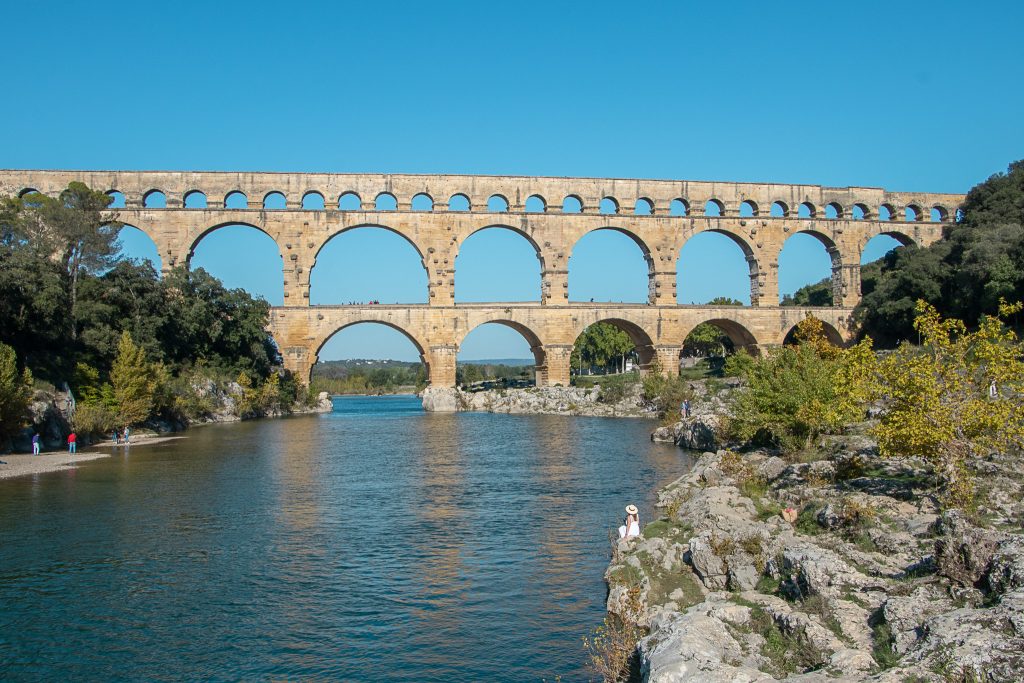
Avignon – What to see in Provence?
Avignon is another place where we would need much more time than we had, mainly to immerse ourselves in the fascinating history of this place, because if we are to be completely honest, this city did not captivate us as much as other corners of Provence. We arrived in Avignon just before sunset, we found a photo point on the map, and when we went there, it turned out that a medieval festival was taking place there. Unfortunately, we have only reached the very end, but at the sight of disguised people and several dozen stylized medieval tents in which they slept with backdrop of a city was quite spectacular.
As you might know Avignon is a city of popes, in the 14th century the apostolic capitol was moved there. This tied to a period of French popes who were not very welcome and safe in Rome. The decision to move to Avignon was made by Pope Clement V in 1309, and the last resident who returned to Rome in 1377 was Gregory XI, the entire period known as the “Captivity of Avignon”. We owe the Popes building of Avignon’s Papal Palace towering over the city, its size is extremely impressive, as well as the Châteauneuf-du-Pape wine region, because it was the popes who appreciated the terroir and excellence of local wines by introducing them to the salons and making them popular.
In the subject of Avignon, one should not forget about the Pont Saint Benezet, also known as the Avignon Bridge, which leads nowhere … Although there is a legend around it, the facts are simply that the bridge was destroyed by the army of Louis VIII during the Cathar expansion and has never been rebuilt.

Roussillon – What to see in Provence?
Roussillon is a red hilltop town made famous by the ochre deposits that surround it. We came to Roussillon for Le Sentier des Ocres, an inactive ochre quarry sometimes called the French Colorado. This comparison seems to be a great exaggeration, because although the quarry in Roussillon makes an impression, it is far from being an American “brother”.
There are two paths in the quarry, shorter (approx. 15 minutes) and longer (approx. 30 minutes) – from our observation, what is most interesting is at the very beginning. Entry to the quarry costs 3 euro per adult and you can enter there from 10 am (as early birds, unfortunately we had to wait a little for the opening). Quarry is ok but the town itself is really nice, situated on a hill with houses in various shades of ochre.
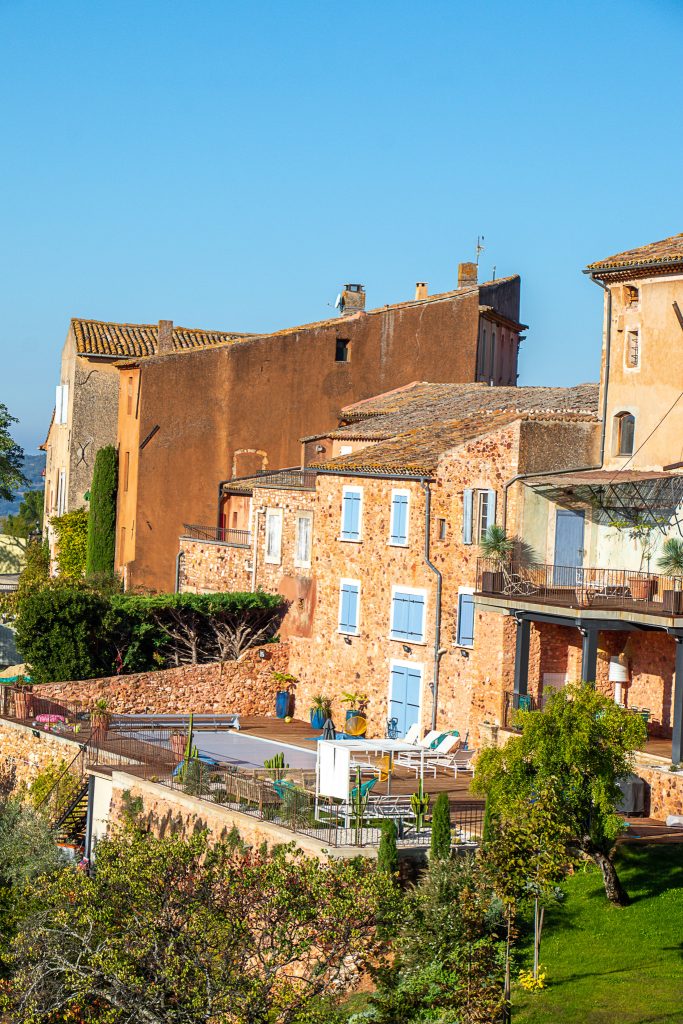
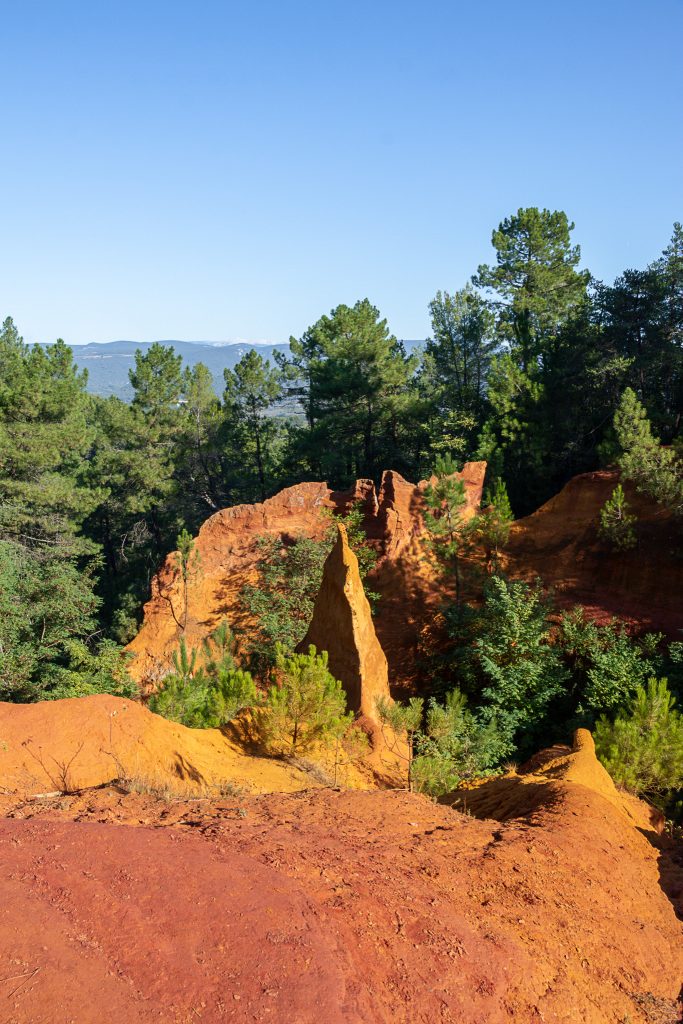
Les Baux de Provence – What to see in Provence?
One of many picturesque Provencal towns, which is distinguished by its location. Les Baux de Provence is located at the top of a rock, and the town overlooks the surrounding rock formations, which remind us a bit of the landscape of the Kraków-Częstochowa Jura Upland. The town itself, like many others in Provence, is very small and charming, in narrow streets you can find shops with regional souvenirs. There are also ruins of the 12th century Château des Baux-de-Provence in Baux that overlook the town. The castle can be visited and an adult ticket costs 8 euros.
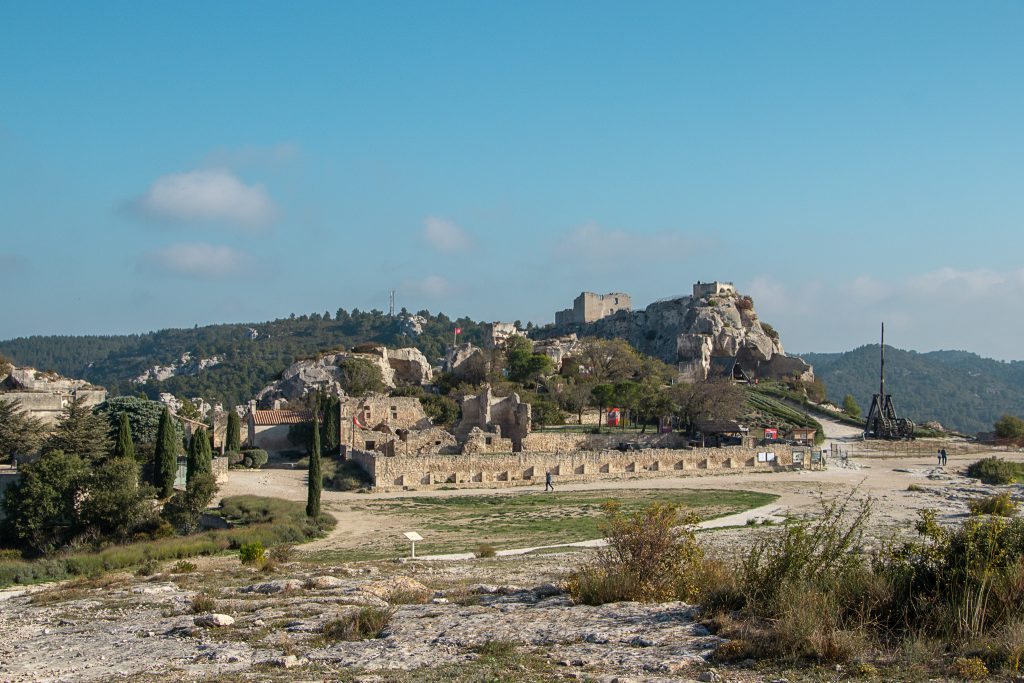
Marseille – What to see in Provence?
Marseille is a huge city where you could probably spend a few days. We only had 3 hours, during which we were able to try the iconic Marseille Bouillabaisse soup, walk around the port and visit the cathedral. If we are to be completely honest, we were ok to skip most of Marseille – it’s a big French city and we rather spend our time in hilltop villages. While in Marseille, you will definitely not miss the Cathédrale La Major cathedral, the building is truly impressive.
You should not bypass the bustling Old Port with a huge number of sailing boats. The port is surrounded by beautiful tenement houses, there are plenty of pubs, and practically all of them serve the famous Bouillabaisse soup prepared with several types of fish and seafood, served with croutons, grated cheese and rouille sauce. The soup, which used to be fishermen’s food and soup made from fish and seafood leftovers, is now a symbol of luxury, as in some places they ask 60 euros per serving, which is reportedly not the most exorbitant amount. We ate our Bouillabaisse in La Cigale, and the pleasure cost us 35 euros per person.
Unfortunately, although we had the restaurant on the recommendation of a French person and there were a lot of locals there, the food wasn’t to die for. Elsewhere on the Cote d’Azur we saw Bouillabaisse properly served – several types of fish were filleted in front of the guests, the soup was served separately and the guests poured it over the fish themselves, the right cutlery is also important – in short, Bouillabaisse is not only a soup, but a whole ritual and only then it makes sense to pay a fortune for it!
After the food satisfaction has not been met, we improved our mood by buying local wine and ice cream from a random booth, and at the end we went up the hill to the Notre Dame de la Garde Basilica. The basilica is amazing itself but its location is just mind-blowing! The view is spectacular and if have to choose one place in Marseille, it should be this one!
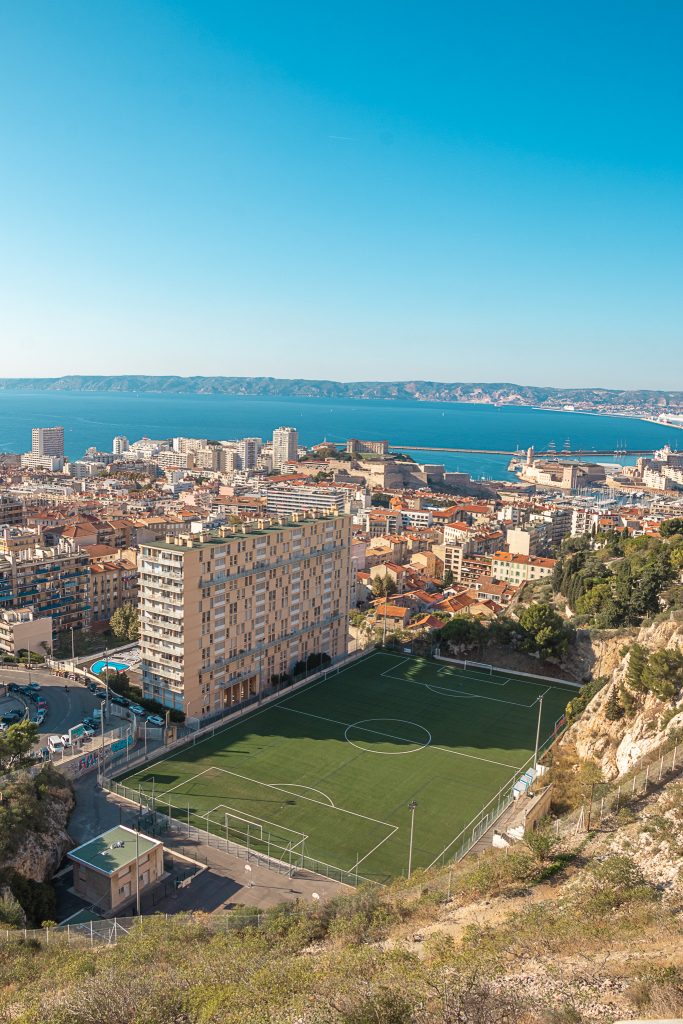
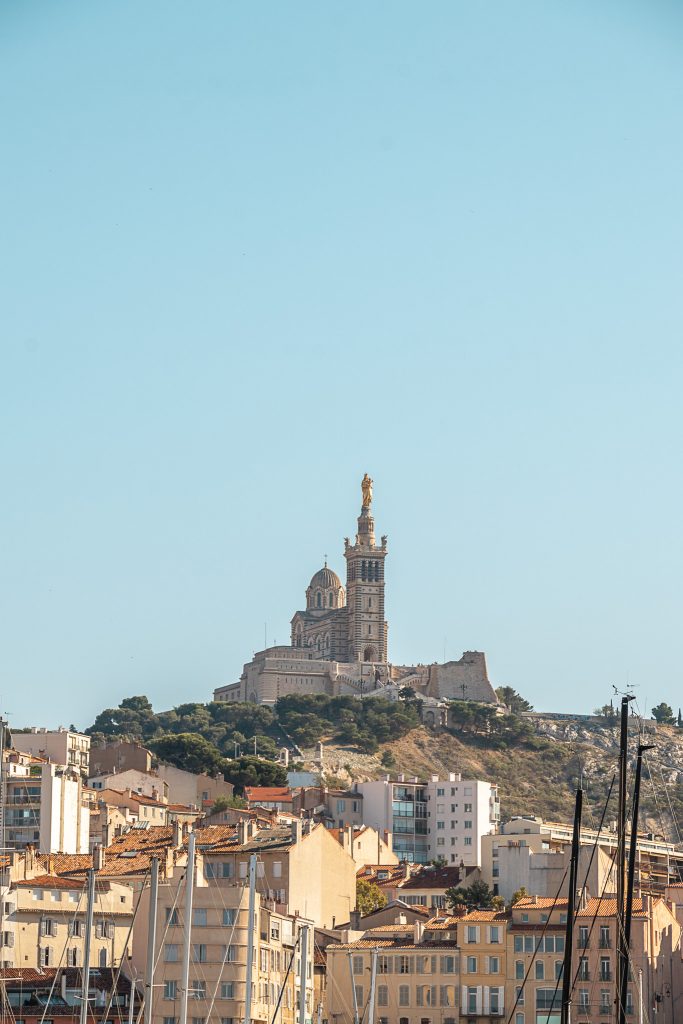
Cap Croisette – What to see in Provence?
If you do not have time for long treks in Calanques, it is worth going to Cape Croisette, which is a smaller version of it. At the very end of the short trekking there is a small fishing village, and apparently also a seaside pub in the season. The views may not take your breath away, but they are very pleasant, and the water has an amazing shade – it is best to go during the day due to the shadow falling from the hills onto the water, its colour is most spectacular in the sun, i.e. around noon.
After quick trekking, we returned to the fishing village of Les Goudes for a picnic and to admire the sunset. Nice place, probably not as touristic as many places in the area, but it won’t blow you away, so you can avoid it 🙂
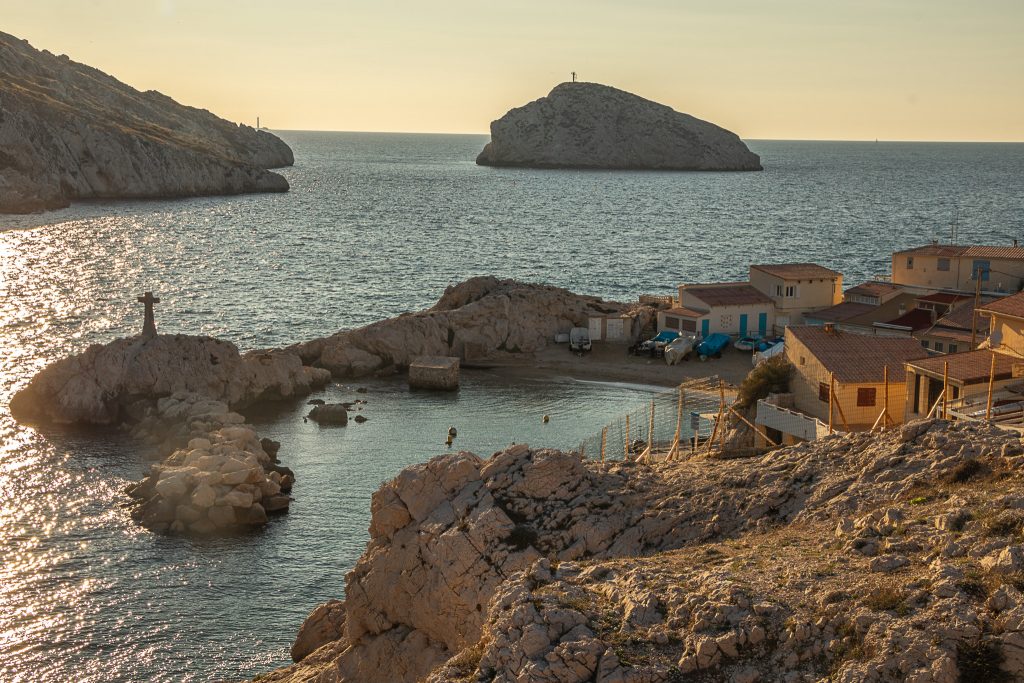
Cassis – What to see in Provence?
Cassis is theoretically the beginning of the Cote d’Azur, but we decided to throw it into one bag with the rest of Provence. Cassis is a small town with a beautiful port, lots of picturesque streets and photogenic buildings, as well as a small beach. Due to the proximity of Marseille, as well as the port, it is said that this is where you can eat Bouillabaisse, but let’s leave this unfortunate soup alone.
Not surprisingly, from our observations, it is also quite expensive there, we drank the most expensive coffee there during the entire trip. Painful memories of expensive coffee were luckily obliterated by the baguette, the best baguette we ate in France! We literally walked all over Cassis in search of an open bakery, which were somehow closed in the morning, and we came across one, the only one for which there was a long queue. We bought a few pastries, but this baguette … Soft inside with a perfectly crispy crust, well perfection of long crusty piece of bread!
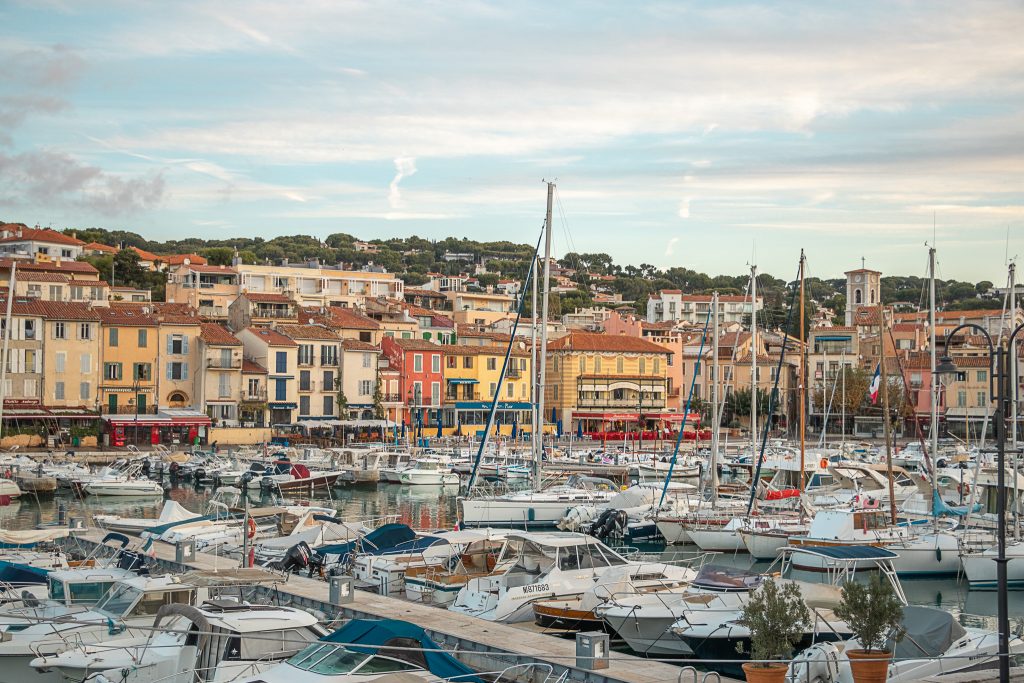
Calanques National Park – What to see in Provence?
When it comes to the Calanques National Park, we messed this one up completely, because we assumed that we would get everywhere on foot quick enough, and as it turned out, Google maps is lying to you if saying it is possible. You have to leave the car by the road and trek a good few kilometres, so we abandoned the idea of seeing Calanque d’En-Vau, supposedly the most picturesque of them. After all, we decided that with such a limited amount of time as we had, the most sensible option would be to choose a boat trip that depart from Cassis (the cheapest start at 20e).
What are Calanques anyway? They are narrow bays cut into the mainland, surrounded by limestone cliffs, the water in the bays has an amazing green-turquoise colour – depending on the depth. Due to the cliffs, it is most beautiful around the midday, when the sun is falling from above and there are no shadows. Calanques is a place worth planning the whole day, because the main means of transport are legs, but we assure you that it is worth it! After Calanque d’En-Vau plan failed, we returned to Cassis from where you can get by car to Calanque de Port-Miou where the port is located, it is the most accessible of all the bays.
The trek to the end of the headland and back took about an hour until we reached the beginning of Calanque Port Pin. If we had more time, we would go via Calanque Port Pin to Calanque d’En-Vau – for the whole event, however, we would have to have much more time, we estimate that with stops for photos and a snack it would be around 4 hours.
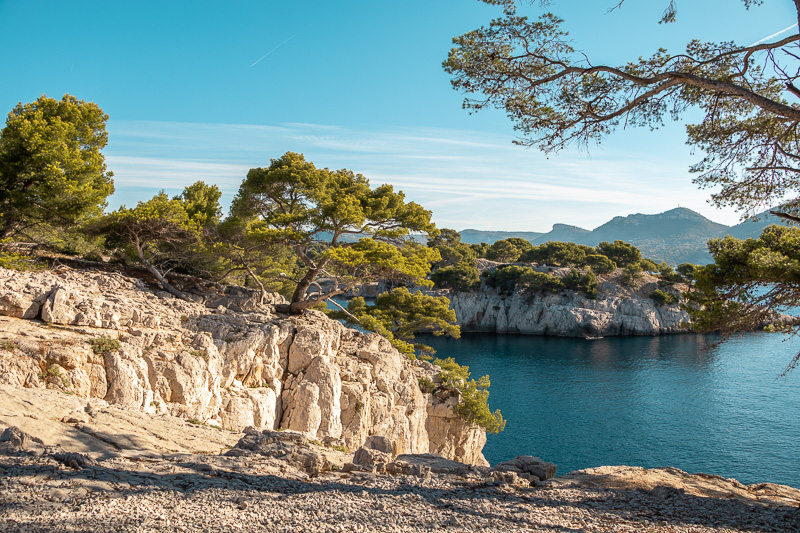
Verdon canyon and Lac de Sainte Croix lake – What to see in Provence?
From the Calanques we rushed north to the Verdon Canyon. Before we got there, however, we saw the Lac de Sainte Croix lake with an unusual, blue colour of water, which usually characterizes glacial or calcareous lakes. Lac de Sainte Croix is an artificial reservoir created several decades ago by the construction of the Sainte-Croix dam. We did not meet many tourists in this area, due to the altitude it was a bit cooler there, the air was fresh and there was a soothing silence – in this setting we organized a picnic, which we were envied by the few stoppings at the viewpoints.
Heading to the viewpoint of the canyon, we drove through the picturesque village of Aiguines, next to which there is a vineyard with a private, restored Chateau, do not ask for the name, because although we managed to track the place on Google Maps, it is incognito, try to navigate on Eglise (you can’t enter the area, but the view of the Chateau in the background of the lake is delightful, which is located right next to the property.
The winding mountain road is an attraction in itself, and to see the canyon and the Verdon River flowing at its bottom, we went to the Point de vue viewpoint. Unfortunately, in the late afternoon the surrounding mountains cast a shadow over it, but the canyon makes an electrifying impression! Due to the late hour, we skipped the scenic route on the other side of the canyon, looking from the place where the viewpoint was located – apparently the views are beautiful, but it is recommended for an experienced driver. There are also many picturesque trekking routes in the area of the Verdon canyon, which, unfortunately, we did not have time for, most of them are 5-7 hours of walking.
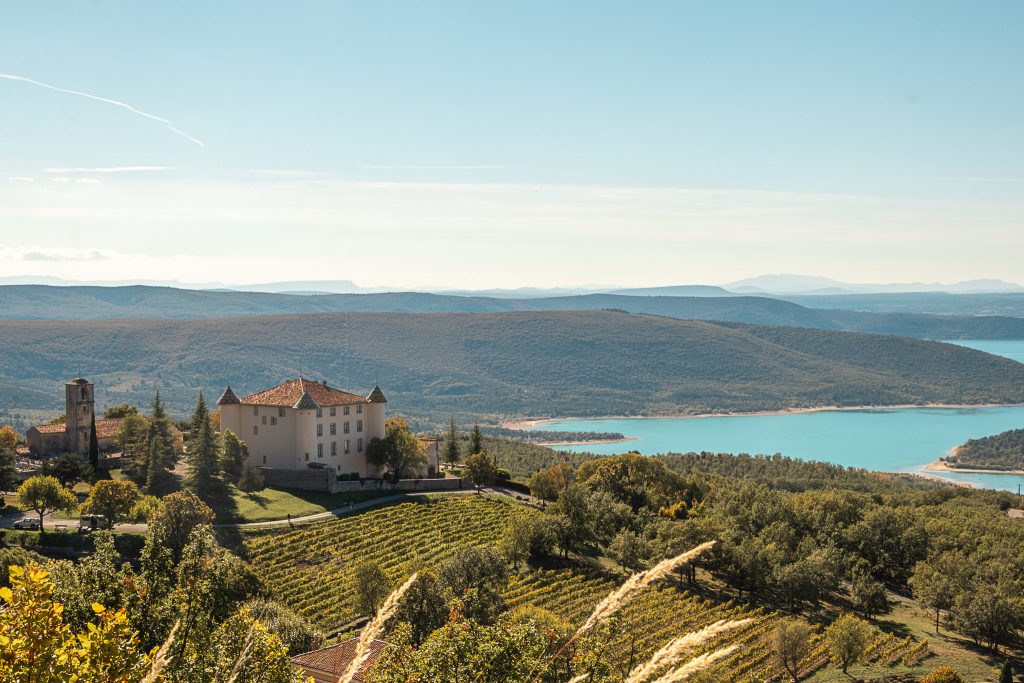
Caillan – What to see in Provence?
Caillan is not the place we planned to visit. We ended up there because of the extremely cheap accommodation, and to be exact, we slept in a cottage / cabin belonging to an elderly hippie who lived in a similar place next door. It was probably the strangest place we’ve ever slept in, but let’s leave that bizzare house for now… – at least it was cheap. Caillan is a hilltop town that you won’t find in your guidebook.
In the evening there was no living soul there (okay, a few locals), no tourists, peace and quiet, picturesque medieval streets illuminated by street lamps and literally one open pub. The lack of interest in this place by tourists, despite its undoubted charm, probably made the greatest impression on us and we wish you could find your “own” village or town in the thicket of those widely described by guides, because memories of such places are the most unique. We were supposed to go for sunrise or sunset to Seillans, but we liked our village so much that we passed!
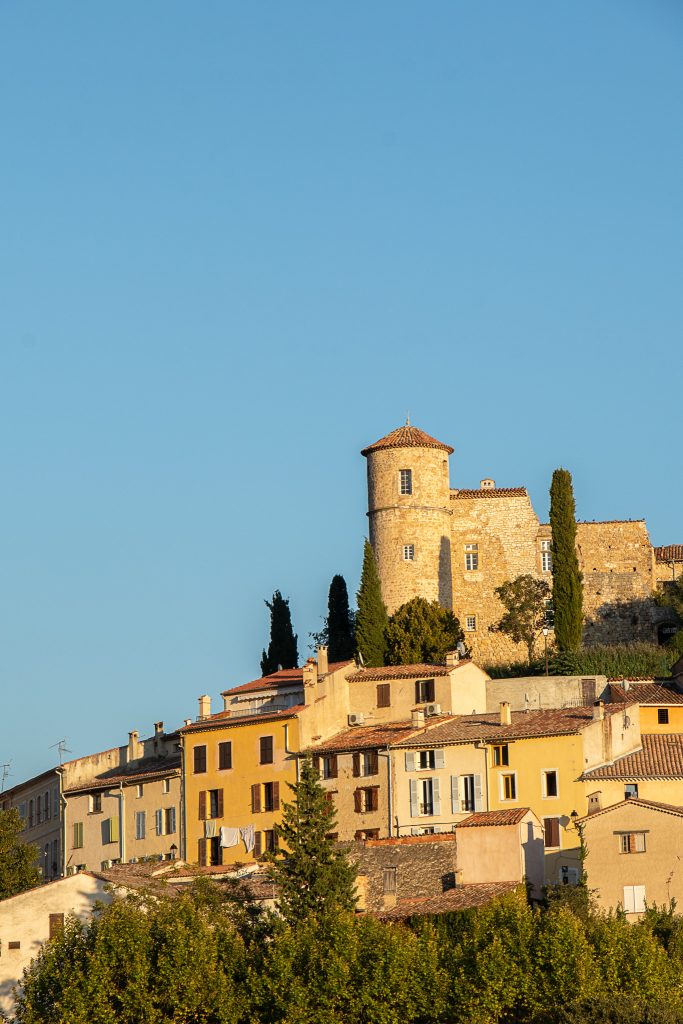
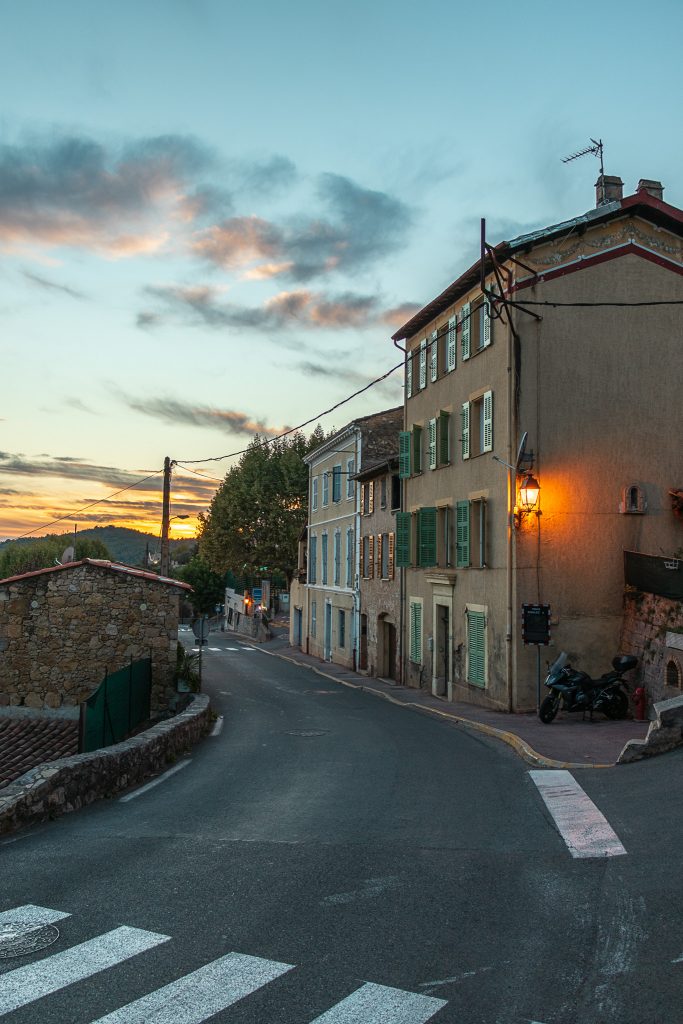
Grasse – What to see in Provence?
While the old town in Grasse was very nice in the pictures, we decided to skip as usual because of tight schedule. So why did we go out of our way to visit Grasse? Grasse is known not only as French, but as the world capital of perfume! Why Grasse? As explained on site, due to the microclimate that allows the cultivation of all the “basic” flowers from which essential oils are made, flowers such as roses, lavender, jasmine and mimosa.
With the current scale of perfume production, some oils are imported from abroad, such as rose oil from Turkey or Bulgaria. There are currently about 70 fragrance factories in Grasse, it is in this town that many famous Chanel and Dior fragrances were created. There are only 200 people in the world, called “Nose” in English, or the nose, as many as 40 of them are French, 38 work in Grasse. “Nose” gets a salary of around 7,700 euros a year (or at least this is the standard in the place we visited), working only 2-3 hours a day. Unfortunately, it is not only pleasures, but also sacrifices, “Nose” cannot drink alcohol or eat spicy foods, as well as those strongly spiced. In Grasse, you can visit the International Perfume Museum, but many manufacturers open their doors to tourists, the three most famous being Galimard, Fragonard and Molinard.
We chose Galimard quite by chance, visiting the small museum is free, but we guarantee that you will not leave empty-handed. Although the sightseeing does not last long, it was one of the most interesting museums we have ever visited, and Aneta is not an easy one to be dragged into the museum. At the end of the tour, you visit the shop, shopping is not obligatory, but it is worth exploring, because it is the paradise of every fragrance enthusiast.
The fragrances offered there are original and you will not find them on store shelves. For 100ml of eau de perfume (that is what designers and big brands sell for horrendous amounts) you will pay only 45e, for real perfumes you will pay only 60 euros (100ml). And now we recommend going to the stores and checking if you can buy perfumes anywhere, because usually the most expensive fragrances are eau de perfume, i.e. fragrances consisting of essential oils and water, when perfumes do not have any added water – simply eau de perfumes are less concentrated. We guarantee that finding such labelled ‘perfumes’ will be a miracle, when you can get it at the manufacturer’s for affordable money. This is because the branding of large labels and packaging are often much more expensive than what is inside, i.e. the fragrance itself … And selling pure perfumes simply does not pay off.
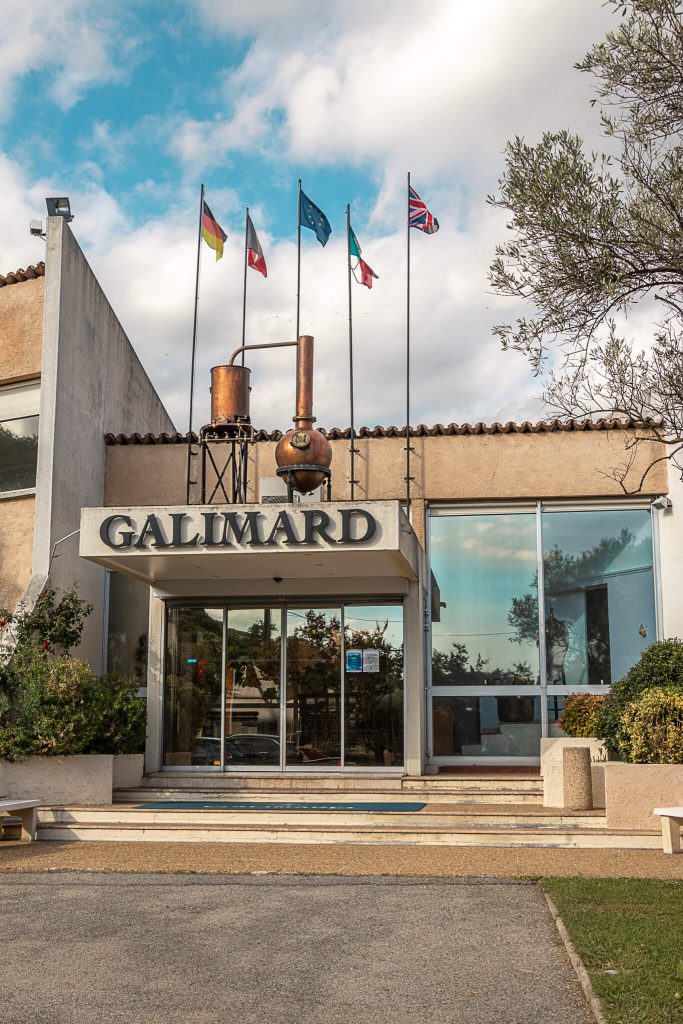
Saint Paul du Vence – What to see in Provence?
A medieval town on a hill with a tangle of shady streets and a very “artistic” atmosphere. The small Saint Paul du Vence is full of art galleries and shops with more and less sophisticated works, mainly modern art. Saint Paul du Vence gained fame probably thanks to the hotel La Colombe d’Or, which was visited by, among others, Pablo Picasso, the village attracted artists and actors. It seems that although artists are probably not there anymore, the ubiquity of art has its explanation!
